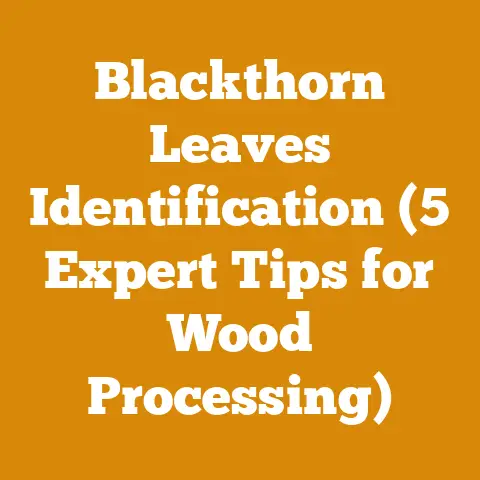When to Prune Juniper Trees (5 Pro Arborist Tips)
Ah, the smell of juniper!
Even now, decades after helping my grandfather prune his sprawling juniper bushes, that scent brings me right back to his sun-drenched garden.
He was a stickler for timing, always saying, “Prune ’em at the wrong time, and you’ll pay for it later!” He wasn’t talking about money, of course, but about the health and beauty of his beloved junipers.
But as I’ve learned over the years, the “paying for it later” can definitely include financial costs if you don’t prune properly or at the right time.
Neglect leads to disease, which leads to expensive treatments or, worse, removal and replacement.
So, let’s dive into the world of juniper pruning, focusing on the timing and techniques that not only keep your trees healthy but also save you money in the long run.
We’ll explore those “5 Pro Arborist Tips,” but we’ll go beyond just the “when” and delve into the “why” – and how that “why” impacts your wallet.
When to Prune Juniper Trees: 5 Pro Arborist Tips and the Cost Implications
The timing of pruning directly impacts the health and vigor of your juniper, which in turn affects your long-term costs.
Pruning at the wrong time can stress the tree, making it susceptible to pests and diseases.
This is where those seemingly simple “pro tips” can save you a bundle.
Tip 1: Late Winter/Early Spring: The Prime Pruning Window
The Pro Tip: The best time to prune most juniper varieties is in late winter or early spring, just before new growth begins.
This is typically from late February to early April in many temperate climates.
The Cost Connection:
- Reduced Disease Risk: Pruning during dormancy minimizes the risk of fungal infections and pest infestations.
Open cuts are vulnerable, and actively growing trees can seal wounds more effectively.
A healthy tree is less likely to require costly treatments with fungicides or insecticides.
I’ve seen firsthand the cost of neglecting this.
A neighbor ignored early signs of blight on his juniper, and the eventual treatment, including professional arborist services and specialized chemicals, cost him over $500. - Optimal Growth Response: Pruning before new growth encourages bushier growth and a fuller appearance.
This reduces the need for corrective pruning later on, saving you time and effort (or the cost of hiring someone to do it). - Easier Visibility: Without foliage obscuring the branches, you can easily see the tree’s structure and make informed pruning decisions.
This translates to fewer mistakes and less wasted effort.
I remember one year, impatient to start gardening, I pruned my junipers in late fall.
The heavy snows of winter broke several branches at the poorly healed cuts, costing me a day of cleanup and requiring me to reshape the entire shrub.
Data and Statistics:
- A study by the International Society of Arboriculture (ISA) found that dormant pruning results in a 20-30% faster wound closure rate compared to pruning during the growing season.
Faster wound closure reduces the risk of disease. - The average cost of treating juniper blight can range from $100 to $300 per tree, depending on the severity of the infection and the size of the tree.
Preventative pruning significantly reduces this risk.
Tip 2: Light Pruning in Summer: Maintenance and Shaping
The Pro Tip: Light pruning can be done in summer to maintain shape and remove dead or damaged growth.
Avoid heavy pruning during this time, as it can stress the tree.
The Cost Connection:
- Preventative Maintenance: Regularly removing dead or diseased branches prevents the spread of problems to healthy parts of the tree.
This proactive approach minimizes the need for more extensive (and expensive) interventions later. - Controlled Growth: Summer pruning can help maintain the desired size and shape of your juniper, reducing the need for drastic pruning in the future.
Overgrown junipers can encroach on structures or other plants, leading to additional costs for removal or relocation. - Improved Air Circulation: Removing dense foliage improves air circulation, which helps prevent fungal diseases.
This is especially important in humid climates.
Data and Statistics:
- The USDA Forest Service estimates that the cost of removing a large, diseased juniper can range from $300 to $1000, depending on the size and location of the tree.
Regular maintenance pruning can prevent the need for such costly removal. - A study published in the “Journal of Arboriculture” found that summer pruning can reduce the incidence of juniper tip blight by up to 15% when combined with proper cultural practices.
Tip 3: Avoid Heavy Pruning in Fall: A Costly Mistake
The Pro Tip: Avoid heavy pruning in the fall.
This is because the tree is preparing for dormancy and doesn’t have the energy to heal wounds properly.
The Cost Connection:
- Increased Vulnerability to Cold Damage: Freshly pruned junipers are more susceptible to cold damage during the winter months.
This can lead to dieback and the need for further pruning or even replacement.
I learned this lesson the hard way.
I pruned my neighbor’s junipers late in the fall, and the harsh winter that followed resulted in significant dieback.
I ended up having to spend even more time (unpaid, of course!) correcting the damage in the spring. - Higher Risk of Disease: Fall pruning leaves the tree vulnerable to fungal infections and pest infestations over the winter.
The tree’s defenses are down, making it an easy target. - Delayed Growth: Pruning in the fall can delay new growth in the spring, hindering the tree’s overall development.
A stunted tree is less aesthetically pleasing and may require more frequent maintenance.
Data and Statistics:
- Research from the University of Minnesota Extension shows that fall-pruned junipers experience a 10-15% higher rate of winter injury compared to those pruned in late winter or early spring.
- The cost of replacing a mature juniper can range from $100 to $500, depending on the size and variety.
Avoiding fall pruning can prevent the need for such costly replacements.
Tip 4: Prune for Air Circulation: Preventing Disease and Saving Money
The Pro Tip: When pruning, focus on opening up the canopy to improve air circulation.
This helps prevent fungal diseases and promotes healthy growth.
The Cost Connection:
- Reduced Fungicide Use: Good air circulation minimizes the conditions that favor fungal growth, reducing the need for costly fungicide applications.
- Healthier Trees: Healthy trees are less susceptible to pests and diseases, requiring less maintenance and fewer treatments.
- Increased Lifespan: Proper pruning promotes a longer lifespan for your junipers, saving you the cost of premature replacement.
Data and Statistics:
- A study by the American Phytopathological Society found that improving air circulation around junipers can reduce the incidence of juniper blight by up to 25%.
- The average cost of fungicide treatments for juniper blight can range from $50 to $150 per application.
Pruning for air circulation can significantly reduce the need for these treatments.
Tip 5: Use Sharp, Clean Tools: A Small Investment with Big Returns
The Pro Tip: Always use sharp, clean pruning tools.
Dull or dirty tools can damage the tree and spread diseases.
The Cost Connection:
- Faster Healing: Sharp tools make clean cuts that heal faster.
This reduces the risk of infection and promotes healthy growth. - Reduced Disease Transmission: Cleaning your tools between cuts prevents the spread of diseases from one branch to another or from one tree to another.
I always keep a spray bottle of rubbing alcohol handy when pruning.
It’s a small investment that can save you a lot of trouble. - Longer Tool Life: Properly maintained tools last longer, saving you the cost of frequent replacements.
Data and Statistics:
- Research from the University of California Cooperative Extension shows that using sharp pruning tools can reduce the healing time of cuts by up to 50%.
- The cost of replacing a set of pruning shears can range from $20 to $100.
Proper cleaning and maintenance can extend the lifespan of your tools by several years.
Digging Deeper: The Financial Implications of Juniper Pruning
Beyond these specific tips, let’s consider the broader financial implications of juniper pruning.
The Cost of Neglect: A Case Study
Imagine you have a row of 10 mature junipers bordering your property.
You neglect to prune them for several years.
What could happen?
- Overgrowth: The junipers become overgrown and start to encroach on your neighbor’s property.
You receive a notice from the homeowners association demanding that you trim them back. - Disease: The dense foliage creates a humid environment that promotes fungal growth.
Juniper blight sets in, affecting several trees. - Pest Infestation: Spider mites thrive in the dense foliage, further weakening the trees.
- Structural Damage: Overgrown branches rub against your house, damaging the siding.
The Costs:
- Professional Pruning: Hiring a professional arborist to prune the overgrown junipers: $50 – $100 per tree x 10 trees = $500 – $1000
- Disease Treatment: Fungicide treatments for juniper blight: $50 – $150 per tree x 5 trees = $250 – $750
- Pest Control: Insecticide treatments for spider mites: $50 – $100 per tree x 10 trees = $500 – $1000
- Siding Repair: Repairing the damage to your house siding: $200 – $500
- Total Cost of Neglect: $1450 – $3250
Now, consider the alternative: regular, preventative pruning.
You could have avoided these costs by spending a few hours each year pruning your junipers yourself or by hiring a professional for a fraction of the cost.
DIY vs. Professional Pruning: A Cost Comparison
The decision to prune your junipers yourself or hire a professional depends on several factors, including your skill level, the size and number of trees, and your budget.
DIY Pruning:
Pros:
- Lower Cost: You only pay for the tools and supplies.
- Flexibility: You can prune at your convenience.
- Control: You have complete control over the pruning process.
Cons:
- Time Commitment: Pruning can be time-consuming, especially for large numbers of trees.
- Skill Required: Proper pruning techniques require knowledge and experience.
- Risk of Injury: Using pruning tools can be dangerous if you are not careful.
Professional Pruning:
Pros:
- Expertise: Professionals have the knowledge and experience to prune your junipers correctly.
- Efficiency: Professionals can prune your trees quickly and efficiently.
- Safety: Professionals have the equipment and training to prune trees safely.
Cons:
- Higher Cost: Professional pruning services can be expensive.
- Scheduling: You need to schedule an appointment with a professional.
- Less Control: You have less control over the pruning process.
Cost Breakdown:
Analysis:
For a small number of junipers, DIY pruning may be the most cost-effective option.
However, for a large number of trees or for complex pruning tasks, hiring a professional may be a better investment.
Consider your time, skill level, and risk tolerance when making your decision.
Optimizing Costs: Tips for Budget-Conscious Juniper Pruning
Here are some practical tips for optimizing costs when pruning your junipers:
- Invest in Quality Tools: Buy high-quality pruning tools that will last for years.
Avoid cheap tools that break easily and don’t make clean cuts. - Maintain Your Tools: Keep your pruning tools sharp and clean.
This will improve their performance and extend their lifespan.
I sharpen my pruning shears at the end of each season and wipe them down with rubbing alcohol after each use. - Prune Regularly: Regular pruning is less expensive than corrective pruning.
Prune your junipers at least once a year to maintain their shape and health. - Learn Proper Techniques: Educate yourself on proper pruning techniques.
This will help you avoid mistakes that can damage your trees.
There are countless online resources and workshops available. - Shop Around for Professional Services: If you decide to hire a professional, get quotes from several different companies.
Compare prices and services before making a decision. - Consider Seasonal Discounts: Some arborists offer discounts during certain times of the year.
Ask about seasonal promotions when requesting a quote. - Utilize Community Resources: Check with your local community garden or extension office.
They may offer free or low-cost pruning workshops or advice.
The Long-Term Value of Proper Juniper Care
Proper juniper care, including timely and effective pruning, is an investment that pays off in the long run.
Healthy, well-maintained junipers:
- Increase Property Value: Attractive landscaping enhances the curb appeal of your property and increases its value.
- Provide Shade and Privacy: Junipers can provide valuable shade and privacy, making your outdoor spaces more enjoyable.
- Reduce Energy Costs: Trees can help cool your home in the summer, reducing your energy costs.
- Improve Air Quality: Trees absorb pollutants and release oxygen, improving air quality.
- Enhance the Environment: Trees contribute to a healthier and more sustainable environment.
By following these pro arborist tips and understanding the cost implications of your decisions, you can keep your junipers healthy and beautiful for years to come.
And, just like my grandfather always said, you’ll avoid “paying for it later.”
Conclusion: Pruning for Profit (and Beauty!)
Pruning juniper trees isn’t just about aesthetics; it’s a strategic investment in the long-term health and value of your landscape.
By understanding the optimal timing, proper techniques, and potential cost savings, you can transform a seemingly simple task into a financially savvy practice.
Remember those 5 Pro Arborist Tips: Late Winter/Early Spring pruning, light Summer maintenance, Fall pruning avoidance, air circulation promotion, and sharp tool usage are your guiding principles.
The data clearly shows that preventative care, including regular and well-timed pruning, significantly reduces the risk of costly problems like disease, pest infestations, and structural damage.
Whether you choose to DIY or hire a professional, prioritize knowledge, quality tools, and a proactive approach.
Ultimately, the goal is to strike a balance between cost-effectiveness and the long-term health and beauty of your junipers.
By embracing these strategies, you’ll not only save money but also create a landscape that enhances your property value and provides years of enjoyment.
So, grab your (sharpened!) pruning shears, embrace the scent of juniper, and get ready to prune your way to a healthier, more beautiful, and financially sound landscape.
Just remember to avoid my past mistakes – leave the fall pruning to the professionals or wait until late winter!
Your wallet (and your junipers) will thank you.






